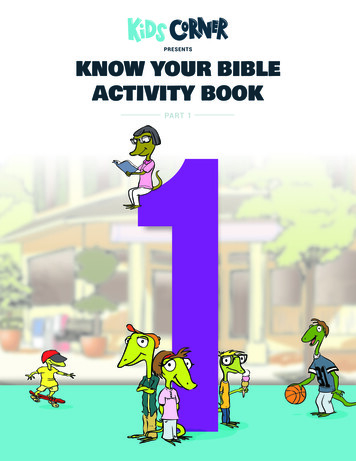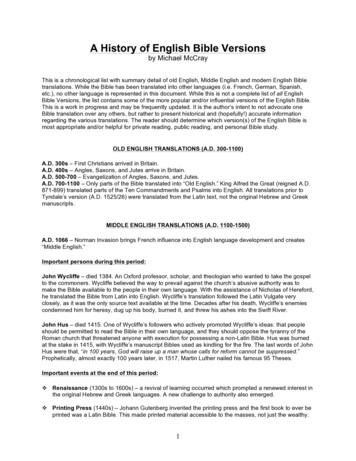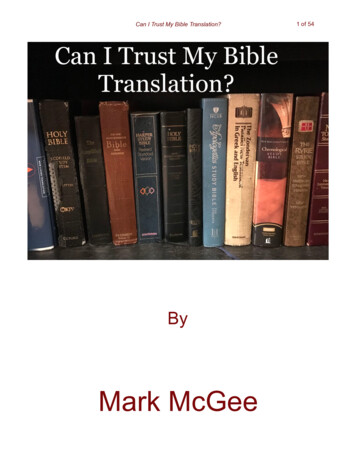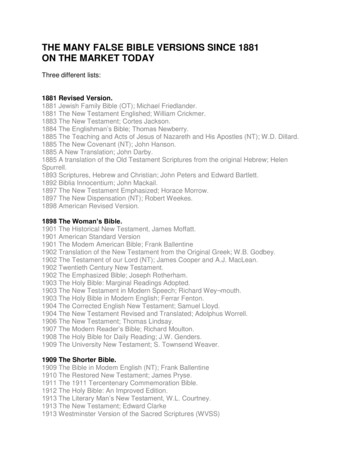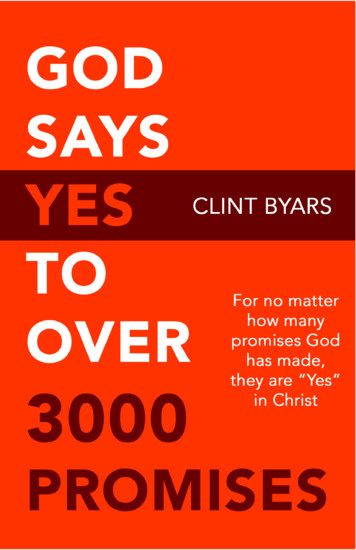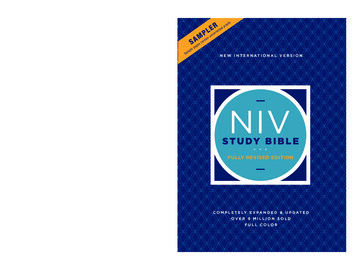
Transcription
PiLn uncorreMontaAS scKnow what the Bible says.Understand why the Bible matters.Set in Zondervan’s exclusive NIV Comfort Print typeface, this stunning,full-color study Bible answers your pressing questions with just the rightamount of information, placed in just the right location.With its decades-long legacy of helping readers grasp the Bible’s meaning,the NIV Study Bible embodies the mission of the NIV translation to be anaccurate, readable, and clear guide into Scripture. Specifically designed toexpand upon the NIV, the NIV Study Bible’s editorial team crafts that sameaccuracy and clarity into every study note.Now the study Bible millions have come to trust has been fully revised andupdated. A new committee of top biblical scholars—who are current andformer NIV translators with a passion for making the Bible’s meaning clear—have pored over every note, every article, every chart, and every essayto refine this treasured resource even more. Thousands of newly writtenor revised notes and articles combine with hundreds of four-color maps,charts, photos, and illustrations to create an entire library of study helpsdesigned to increase your understanding and application of God’s word.F E AT U R E S : Complete text of the accurate, readable, and clear New InternationalVersion (NIV) Over 21,000 bottom-of-the-page study notes, with icons to make importantinformation easy to spot Over 125 topical articles, 16 pages of full-color maps, the full NIVconcordance, and subject note indexes enable even deeper study Sixty-six book introductions and outlines along with six sectionintroductions provide valuable background information for each book of theBible In-text maps, charts, diagrams, and illustrations visually clarify the stories inthe Bible Words of Jesus in red Exclusive Zondervan NIV Comfort Print typefaceEvery NIV Bible you purchase helps Biblica translateand give Bibles to people in need around the world.www.biblica.comrooRdpetE cwww.TheNIVStudyBible.comSampler 25-Pack: ISBN 9780310113782BIBLES / New International Version / StudySamplepagefs
U P D AT E D E D I T I O NMATTHEW 1:110The Genealogy of Jesus the Messiah1:1-17pp — Lk 3:23-381:3-6pp — Ru 4:18-221:7-11pp — 1Ch 3:10-171This is the genealogy a of Jesus the Messiah b the son of David, a the son of Abraham: b² Abraham was the father of Isaac, cIsaac the father of Jacob, dJacob the father of Judah and hisbrothers, e³ Judah the father of Perez and Zerah, whose mother was Tamar, fPerez the father of Hezron,Hezron the father of Ram,⁴ Ram the father of Amminadab,Amminadab the father of Nahshon,Nahshon the father of Salmon,⁵ Salmon the father of Boaz, whosemother was Rahab, gBoaz the father of Obed, whosemother was Ruth,Obed the father of Jesse,⁶ and Jesse the father of King David.hDavid was the father of Solomon,whose mother had been Uriah’swife, i⁷ Solomon the father of Rehoboam,Rehoboam the father of Abijah,Abijah the father of Asa,⁸ Asa the father of Jehoshaphat,Jehoshaphat the father of Jehoram,The Gospelsspels and the Early ChurchNow easier to read withNIV Comfort Print ¹² After the exile to BabBabylon:ylon:fatherJeconiah was the father of Shealtiel,lShealtiel the fafatherther of Zerubbabel,m¹³ Zerubbabel the fafatherther of Abihud,Abihud,Abihud the fatherfather of Eliakim,fatherEliakim the father of Azor,¹⁴ Azor the fafatherther of ZaZadok,dok,fatherZadok the father of Akim,fatherAkim the father of Elihud,¹⁵ Elihud the father of Eleazar,Eleazar the father of Matthan,Matthan the father of Jacob,¹⁶ and Jacob the father of Joseph,the husband of Mary, n and Marywas the mother of Jesus who iscalled the Messiah. o1:10 j 2Ki 20:211:11 k 2Ki 24:14-16;Jer 27:20; 40:1;Da 1:1, 21:12 l 1Ch 3:17m 1Ch 3:19; Ezr 3:21:16 n Lk 1:27o Mt 27:171:1–16 For a comparison of Matthew’s genealogy with Luke’s,see note on Lk 3:23–38. The types of people (including Gentiles) mentioned in this genealogy reveal the broad scope ofthose who make up the people of God as well as the genealogy of Jesus.1:1 son of David. A Messianic title (see Introduction: Recipients; Purpose; see also note on 9:27) found several times inthis Gospel (in 1:20 it is not a Messianic title). Jesus fulfillsthe Davidic covenant (see 2Sa 7:5–16 and note on 7:11). son ofAbraham. Because Matthew was writing primarily to Jews,it was important to identify Jesus in this way. Jesus fulfillsthe Abrahamic covenant (see Ge 12:2–3; 15:9–21; 17; 22:15–18;Zec 9:10 and note).1:3 Tamar. In Matthew’s genealogy five women are named:Tamar (here), Rahab (v. 5), Ruth (v. 5), Bathsheba (not by namebut by description—“Solomon, whose mother had been Uriah’s wife,” v. 6) and, of course, Mary (v. 16). All these womenwere in some sense on the margins of society. At least threeof them were Gentiles (Tamar, Rahab and Ruth). Bathshebawas probably an Israelite (1Ch 3:5) but was closely associatedwith the Hittites because of Uriah, her Hittite husband. Byincluding them (contrary to custom) in his genealogy, Matthew indicates at the very outset of his Gospel that God’sgrace is not limited to the people of Israel. Also because allfive of these women were associated, rightly or wrongly,with suspicions of sexual impropriety, Matthew is showingthat the Messiah’s genealogy is not limited to the upright.1:4 Amminadab. Father-in-law of Aaron (Ex 6:23).1:5 Rahab. See notes on v. 3; Heb 11:31; Jas 2:25; see also9780310451495 int 05a sampler copy.indd 10Jehoram the father of Uzziah,father⁹ Uzziah the fafatherther of Jotham,fatherJotham the father of Ahaz,Ahaz the fatherfather of Hezekiah,¹⁰ Hezekiah the fatherfather of Manasseh, jManasseh the father of Amon,Amon the fatherfather of Josiah,¹¹ and Josiah the father of Jeconiah cand his brothersbrothers at the time ofthe exile to Babylon.Babylon. k1:1 a 2Sa 7:1216; Isa 9:6, 7;11:1; Jer 23:5,6; S Mt 9:27;Lk 1:32, 69;Rev 22:16b Ge 22:18;S Gal 3:161:2 c Ge 21:3,12 d Ge 25:26e Ge 29:35; 49:101:3 f Ge 38:27-301:5 g S Heb 11:311:6 h 1Sa 16:1;17:12 i 2Sa 12:24¹⁷ Thus there were fourteen generationsin all from Abraham to David, fourteenfrom David to the exile to Babylon, andfourteen from the exile to the Messiah.a1b 1 Or Jesus Christ.Or is an account of the originMessiah (Hebrew) and Christ (Greek) both meanc 11 That is,Anointed One; also in verse 18.Jehoiachin; also in verse 12Jos 2. Since quite a long time had elapsed between Rahaband David and because of Matthew’s desire for systematicorganization (see note on v. 17), many of the generationsbetween these two ancestors were assumed, but not listed,by Matthew. Ruth. See note on v. 3.1:6 Solomon, whose mother. His mother was Bathsheba (seenote on v. 3).1:8 Jehoram the father. Matthew calls Jehoram the father ofUzziah, but from 2Ch 21:4—26:23 it is clear that, again, several generations were assumed (Ahaziah, Joash and Amaziah) and that “father” is used in the sense of “forefather”or “ancestor” (see NIV text notes on 1Ch 1:5,10).1:11 Josiah the father. Similarly (see note on v. 8), Josiah iscalled the father of Jeconiah (i.e., Jehoiachin; see NIV textnote), whereas he was actually the father of Jehoiakim andthe grandfather of Jehoiachin (2Ch 36:1–9). the exile to Babylon. In chs. 1–2 Matthew emphasizes the theme of Israel’sexile and return. In Jesus’ ministry, God’s people experiencethe restoration that was associated with the return fromexile (see 2:18 and note).1:12 Shealtiel the father. See note on 1Ch 3:19.1:16 husband of Mary. Matthew does not say that Josephwas the father of Jesus but only that he was the husbandof Mary and that Jesus was born of her. In the genealogyand in the birth account (1:18–25), Matthew shows that, although Jesus is not the physical son of Joseph, he is thelegal son and therefore a descendant of David (see Lk 2:33;Jn 1:45 and notes). Mary . . . mother of Jesus. See note on v. 3.1:17 fourteen generations . . . fourteen . . . fourteen. These10/8/19 4:44 PM
U P D AT E D E D I T I O NMATTHEW 3:416who was spoken of through the prophetIsaiah:“A voice of one calling in the wilderness,‘Prepare the way for the Lord,make straight paths for him.’ ” a b⁴ John’s c clothes were made of camel’shair, and he had a leather belt aroundhis waist. d His food was locusts e and wildhoney. ⁵ People went out to him from Jerusalem and all Judea and the whole region of the Jordan. ⁶ Confessing their sins,they were baptized f by him in the JordanRiver.⁷ But when he saw many of the Pharisees and Sadducees coming to wherehe was baptizing, he said to them: “Youbrood of vipers! g Who warned you to fleefrom the coming wrath? h ⁸ Produce fruitin keeping with repentance. i ⁹ And do notthink you can say to yourselves, ‘We haveAbraham as our father.’ j I tell you that outof these stones God can raise up childrenfor Abraham. ¹⁰ The ax is already at theroot of the trees, and every tree that doesThe Gospels and the Early Church3:3 b Isa 40:3;Mal 3:1; Lk 1:76;Jn 1:233:4 c S Mt 3:1d 2Ki 1:8e Lev 11:223:6 f ver 11;S Mk 1:43:7 g Mt 12:34;23:33 h S Ro 1:183:8 i Ac 26:203:9 j S Lk 3:8The Baptism of Jesus3:13-17pp — Mk 1:9-11; Lk 3:21,22; Jn 1:31-343:10 k Mt 7:19;Lk 3:9; 13:6-9;Jn 15:2, 63:11 l ver 6;S Mk 1:4m S Mk 1:8n Isa 4:4; Ac 2:3, 43:12 o Mt 13:30;S 25:413:13 p S Mt 3:1;S Mk 1:4life—and the creationeation of a new order of righteousness andpeace. The idea of God’s kingdom is central to Jesus’ teach-ing and is mentioned 50 times in Matthew alone. has comenear. The presence and the power of God’s reign has alreadybegun to be experienced (see 4:17; Mk 1:15).3:3 All four Gospels quote Isa 40:3 (Luke quotes two addi-tional verses) and apply it to John the Baptist. make straightpaths for him. Equivalent to “Prepare the way for the Lord”(see note on Lk 3:4). The preparation was thoroughgoing—impacting all areas of life.3:4 camel’s hair . . . leather belt. Worn by Elijah and otherprophets (see 2Ki 1:8; Zec 13:4–6 and notes). locusts and wildhoney. People living in the wilderness often ate insects, andlocusts were among the clean foods (Lev 11:21–22). John’ssimple food, clothing and lifestyle were a visual protestagainst self-indulgence and injustice (see Lk 3:10–14).3:6 Confessing their sins. See Pr 28:13; 1Jn 1:9 and notes. theywere baptized by him. Although writings contemporary withthe Gospels provide no exact parallel to Jewish baptism, it ispossible that John’s baptizing activity was meant to imitatebaptism of new converts to Judaism. If so, then John wasinviting his fellow Jews to return to the covenant and totheir God. Jordan River. See note on Mk 1:5 and map below.3:7 Pharisees and Sadducees. See essay, p. 1576, and chart,p. 1631. The Pharisees (see notes on Mk 2:16; Lk 5:17) werea separatistic group focused on the law and its interpretation, who kept both the law of Moses and the unwritten“tradition of the elders” (15:2; later codifed in the Mishnahand Talmud). The Sadducees (see notes on Mk 12:18; Lk20:27; Ac 4:1) were more politically minded and had theological differences with the Pharisees, including denial ofthe resurrection, angels and spirits (Ac 23:8). baptizing. Seenote on Mk 1:4. the coming wrath. The arrival of the Messiahwill bring repentance (v. 8) or judgment.3:9 We have Abraham as our father. See Jn 8:39. Salvationdoes not come as a birthright (even for the Jews) but throughfaith in Christ (Ro 2:28–29; Gal 3:7,9,29). children for Abraham. The true people of God are not limited to the physicaldescendants of Abraham, as Matthew highlights elsewhere(1:3,5,6; 8:5–13; 15:21–28; 28:19–20; cf. Ro 9:6–8 and notes).3:10 The ax is already at the root of the trees. John preaches9780310451495 int 05a sampler copy.indd 16not produce good fruit will be cut downand thrown into the fire. k¹¹ “I baptize you with b water for repentance. l But after me comes one who ismore powerful than I, whose sandals Iam not worthy to carry. He will baptizeyou with b the Holy Spirit m and fire. n ¹² Hiswinnowing fork is in his hand, and he willclear his threshing floor, gathering hiswheat into the barn and burning up thechaff with unquenchable fire.” o¹³ Then Jesus came from Galilee to theJordanJordan to be baptizedbaptized by John.p ¹⁴But¹⁴But Johntried to deterdeter him, saying, “I need to bebaptizedbaptized by you, and do you come to me?”¹⁵ Jesus replied,replied, “Let it be so nonow; it isproperproper for us to do this to fulfill all righteousness.”teousness.” Then John consented.¹⁶ As soon as Jesus was baptized, he¹⁶Aswent up out of the water. At that momentEvery note has beenevaluated to include newhistorical and culturalinsights not covered in3 Isaiah 40:311 Or inthe previous editionthat judgment is near. every tree that does not produceabgood fruit. Cf. Jn 15:2 and note.3:11 with water for repentance. John’s baptism presupposedrepentance; he condemned the Pharisees and Sadduceesbecause they failed to give any evidence of repentance(vv. 7–8). whose sandals I am not worthy to carry. See note onJn 1:27. carry. Mark (1:7) and Luke (3:16) have “untie” (a differdifferent Greek verb), but the Greek here for “carry” can also mean“remove.” baptize you with the Holy Spirit. See Jn 1:33 andnote. with the Holy Spirit and fire. Demonstrated in a dramatic way at Pentecost (Ac 1:5,8; 2:1–13; 11:16), though here“fire” may refer to judgment to come (see v. 12). The outpouring of the Holy Spirit on all God’s people was promised inJoel 2:28–29 and was at least partially fulfilled in Ac 2:16–21.3:12 His winnowing fork. For the process of winnowing, seenote on Ru 1:22. Here it is figurative for the separation of therighteous (“wheat”) from the wicked (“chaff”). unquenchable fire. Eschatological judgment (see 25:41 and note; cf. La1:13 and note). The OT prophets and NT writers sometimescompress the first and second comings of Christ so thatthey seem to be one event (see, e.g., Isa 61:2 and note).3:13 Jesus . . . baptized by John. See map and accompanyingtext, p. 1597.3:15 Jesus’ baptism marked the beginning of his Messianic ministry. There were several reasons for his baptism: (1) The first, mentioned here, was “to fulfill all righteousness.” His baptism indicated that he was consecratedto God and officially approved by him, as especially shownin the descent of the Holy Spirit (v. 16) and the words of theFather (v. 17; cf. Ps 2:7; Isa 42:1). All God’s righteous requirements for the Messiah were fully met in Jesus. (2) At Jesus’baptism John publicly announced the arrival of the Messiahand the inception of his ministry (Jn 1:31–34). (3) By his baptism Jesus completely identified himself with humanity’ssin and failure (though he himself needed no repentance orcleansing from sin), becoming our substitute (2Co 5:21).(4) His baptism was an example to his followers.3:16–17 All three persons of the Trinity are clearly seenhere (see 28:19 and note).3:16 Spirit of God. The Holy Spirit came upon Jesus toequip him (see note on Jdg 3:10) for his work as the10/8/19 4:44 PM
U P D AT E D E D I T I O N11The Gospels and the Early ChurchJoseph Accepts Jesus as His Son¹⁸ This is how the birth of Jesus the Messiah came about a: His mother Mary waspledged to be married to Joseph, but before they came together,togetherer, she was foundto be pregnant through the Holy Spirit.Spirit. p¹⁹ Because Joseph her husbandhusband was faithful to the law, and yet b did not want toexpose her to public disgrace,disgrace, he had inquietly.mind to divorce q her quietly.²⁰ But afterer he had conconsideredsidered this, anappeared to him in aangel r of the Lord appearedsDavid,avid,avid, dodream and said, “Joseph son of Daaid to take Mary home as yournot be afraidause what is conceivedwife, becauseconceived in her is²¹ She will give birthfrom the Holy Spirit. ²¹Sheo a son, and you are to give him the nametopeoplepleJesus, c t because he will save his peofrom their sins.” uv²² All this tookook place to fulfillfulfill whatthe Lord had said through the prophet:prophet:Every note has beenevaluated to includenew thematic insightsnot covered in theprevious edition1:18 p Lk 1:351:19 q Dt 24:11:20 r S Ac 5:19s S Mt 27:191:21 t S Lk 1:31u Ps 130:8;S Lk 2:11;S Jn 3:17; Ac 5:31;S Ro 11:14; Titus 2:141:22 v Mt 2:15,17 23; 4:14; 8:17;17,12:17; 21:4; 26:54,56; 27:9; Lk 4:21;21:22; 24:44;Jn 13:18; 19:24,28, 361:23 w Isa 7:14;8:8, 101:24 x S Ac 5:191:25 y ver 21;S Lk 1:312:1 z Lk 2:4-7a Lk 1:52:2 b Jer 23:5;Mt 27:11; Mk 15:2;Lk 23:38;Jn 1:49; 18:33-37c Nu 24:17divisions reflect two characteristics of Matthew’s Gospel:(1) an apparent fondness for numbers and (2) concern forsystematic arrangement. The number 14 may have beenchosen because it is twice seven (the number of completeness) and/or because it is the numerical value of the nameDavid (see notes on Pr 10:1; Rev 13:17). For the practice oftelescoping genealogies to achieve the desired number ofnames, see Introduction to 1 Chronicles: Genealogies.1:18—2:23 Matthew frames what he communicates aboutJesus’ infancy with five specific OT texts.1:18 pledged to be married. There were no sexual relationsduring a Jewish betrothal period, but it was a much morebinding relationship than a modern engagement and couldbe broken only by divorce (v. 19). In Dt 22:24 a betrothedwoman is called a “wife,” though the preceding verse speaksof her as being “pledged to be married.” Matthew uses theterms “husband” (v. 19) and “wife” (v. 24) of Joseph and Marybefore their marriage was consummated (see note on Joel1:8). the Holy Spirit. The common NT way of referring to thedivine Spirit, who in the OT was almost always called “theSpirit of God” or “the Spirit of the LORD.” See Ps 51:11 andnote. Christian reflection on the biblical testimony about theSpirit (see 3:16–17; 28:19; 2Co 13:14 and notes) led to the understanding that he is one of the three persons of the Trinity.1:19 divorce her quietly. He would sign the necessary legal papers but not have her judged publicly and stoned (Dt 22:23–24).1:20 in a dream. The phrase occurs five times in the first twochapters of Matthew (here; 2:12,13,19,22) and indicates themeans the Lord used for speaking to Joseph. Joseph son ofDavid. See notes on 1:1,16; perhaps a hint that the messageof the angel related to the expected Messiah. take Maryhome as your wife. They were legally bound to each otherbut not yet living together as husband and wife. what isconceived in her is from the Holy Spirit. This agrees perfectlywith the announcement to Mary (Lk 1:35), except that thelatter is more specific (see note on Lk 1:26–35).1:21 the name Jesus. See NIV text note; the meaning is morespecifically explained in the rest of the verse. save. See Lk2:11 and note.1:22 fulfill. Twelve times (here; 2:15,23; 3:15; 4:14; 5:17; 8:17; 12:17;13:14,35; 21:4; 27:9) Matthew uses a fulfillment formula (e.g.,“this took place to fulfill . . . ”) when speaking of the OT beingfulfilled in the events of Jesus’ life. Some of these are uniquelyfulfilled by Jesus, while others are typological, where Jesus isthe ultimate fulfillment of an OT type (see note on 2:15).9780310451495 int 05a sampler copy.indd 11MATTHEW 2:2²³ “The virgin will conceive and give birthto a son, and they will call him Immanuel” d w (which means “God with us”).²⁴ When Joseph woke up, he did whatthe angel x of the Lord had commanded him and took Mary home as his wife.²⁵ But he did not consummate their marriage until she gave birth to a son. And hegave him the name Jesus. yThe Magi Visit the Messiah2After Jesus was born in Bethlehem inJudea,z during the time of King Herod,aMagie from the east came to Jerusalem ²andasked, “Where is the one who has been bornking of the Jews?b We saw his starc when itrose and have come to worship him.”a 18 Or The origin of Jesus the Messiah was like thisb 19 Or was a righteous man andc 21 Jesus is theGreek form of Joshua, which means the LORD saves.d 23 Isaiah 7:14e 1 Traditionally wise men1:23 See note on Isa 7:14. This is the first of about 50 quotations, many of them Messianic in some sense, that Matthewtaktakes from the OT (see NIV text notes throughout Matthew).1:24 angel of the Lord. See Lk 2:9 and note.1:25 he did not consummate their marriage until she gavebirth. Both Matthew and Luke (1:26–35) make it clear thatJesus was born of a virgin. Although this doctrine is oftenquestioned, Jesus’ virgin birth is an essential truth of theChristian faith. he gave him the name Jesus. Since it was thefather’s prerogative to name children (e.g., Lk 1:60), the ememphasis on Joseph naming Jesus at the climactic moment ofthe birth account highlights the act of adoption by Josephthat makes Jesus his legal son.2:1 Bethlehem in Judea. A village about five milessouth of Jerusalem (see photo, p. 1499). Matthewsays nothing of the events in Nazareth (cf. Lk 1:26–56). Possiblywanting to emphasize Jesus’ Davidic background, he beginswith the events that happened in David’s hometown. It iscalled “Bethlehem in Judea,” not only to distinguish it from thetown of the same name about seven miles northwest of Nazareth, but also to emphasize that Jesus came from the tribe(Judah) and territory that produced the line of Davidic kings.That Jews expected the Messiah to be born in Bethlehem andto be from David’s family is clear from Jn 7:42. King Herod.Herod the Great (37–4 BC), to be distinguished from the otherHerods in the Bible (see chart, pp. 1592–1593). Herod was a nonJew, an Idumean, who was appointed king of Judea by the Roman Senate in 40 BC and gained control in 37. He was a ruthlessruler, murdering his wife, three of his sons, his mother-in-law,his brother-in-law, his uncle and many others he suspected oftreachery—not to mention the male babies in Bethlehem(v. 16). His reign was also noted for splendor, as seen in themany theaters, amphitheaters, monuments, pagan altars, fortresses and other buildings he erected or refurbished—including the greatest work of all, the rebuilding of the templein Jerusalem, begun in 19 or 20 BC and finished 68 years afterhis death (see note on Jn 2:20). Magi. Probably astrologers, perhaps from Persia or southern Arabia or Mesopotamia (“Between the Rivers”), all of which are east of the Holy Land. Jerusalem. Since they were looking for the “king of the Jews” (v. 2),they naturally came to the Jewish capital city (see maps,pp. 1660, 2525).2:2 king of the Jews. Indicates the Magi were Gentiles. Matthew wants to show that people of all nations acknowledged Jesus as “king of the Jews” and came10/8/19 4:44 PM
U P D AT E D E D I T I O NMATTHEW 2:1214and presented him with gifts g of gold,frankincense and myrrh. ¹² And havingbeen warned h in a dream i not to go backto Herod, they returned to their countryby another route.The Escape to Egypt¹³ When they had gone, an angel j of theLord appeared to Joseph in a dream. k “Getup,” he said, “take the child and his mother and escape to Egypt. Stay there until Itell you, for Herod is going to search forthe child to kill him.” l¹⁴ So he got up, took the child and hismother during the night and left forEgypt, ¹⁵ where he stayed until the deathof Herod. And so was fulfilled m what theLord had said through the prophet: “Outof Egypt I called my son.” a n¹⁶ When Herod re al ized that he hadbeen outwitted by the Magi, he was furious, and he gave orders to kill all theThe Gospels and the Early Church2:11 g Ps 72:102:12 h Heb 11:7i ver 13, 19, 22;S Mt 27:192:13 j S Ac 5:19k ver 12, 19,22; S Mt 27:19l Rev 12:42:15 m ver 17,23; S Mt 1:22n Ex 4:22, 23;Hos 11:1boys in Bethlehem and its vicinity whowere two years old and un der, in accordance with the time he had learnedfrom the Magi. ¹⁷ Then what was saidthrough the prophet Jeremiah was fulfilled: o¹⁸ “A voice is heard in Ramah,weeping and great mourning,Rachel p weeping for her childrenand refusing to be comforted,because they are no more.” b qThe Return to Nazareth2:17 o ver 15, 23;S Mt 1:222:18 p Ge 35:19q Jer 31:152:19 r S Ac 5:19s verer 12, 13, 22;S Mt 27:192:20 t Ex 4:19child Jesus and his mother are mentioned together, heis mentioned first (vv. 11,13–14,20–21). gold . . . frankincense . . . myrrh. Three gifts perhaps gave rise to the legend that there were three Magi. But the Bible nowhereindicatestes the number of the Magi, and they were almostcertainly not kings (see note on v. 1). myrrh. See note onGe 37:25.2:13 angel of the Lord. See note on Lk 2:9.2:15 the death of Herod. In 4 BC. Out of Egypt I calledmy son. This quotation from Hos 11:1 refers in thatcontext to God’s calling the nation of Israel out of Egyptin the time of Moses. But Matthew, under the inspirationof the Spirit, applies it also to Jesus thus identifyingw Israel coming out of Egypt. MatthewJesus as the newsees the history of Israel (God’s “son”) recapitulated inGod’s unique Son). Just as Israel as anthe life of Jesus (God’s¹⁹ After Herod died, an angel r of theJoseph inLord appearedappeared in a dream s to Joseph²⁰ and said, “Get up, take the childEgypt ²⁰andmotherand his mother and go to the land of Israel, for those who were trying to take thechild’s life are dead.” t²¹ So he got up, took the child and his²¹SoIncludes over one hundrednew articles in addition to15 Hosea 11:118 Jer. 31:15hundreds of maps, charts,infant nation went down into Egypt,andso theillustrationschild Jesusabwent there. And as Israel was led by God out of Egypt, soalso was Jesus.2:16 kill all the boys . . two years old and under. The numthouber killed has often been exaggerated as being in the thousands. In so small a village as Bethlehem, however (evenwith the surrounding area included), the number waslarge—thougho course, was no lessprobably not large—though the act, ofbrutal.2:18 Originally referencing mothers in Judah lamentingtheir sons being exiled to Babylonia (see note on Jer 31:15).The OT contexts of all three citations in Mt 2 so far (2:6,15,18)focus on the promise of return from exile. Matthew seemsto be using these quotations to highlight Jesus as fulfillment of Scripture and to signal that Jesus brings about theend of his people’s exile.Typology and JesusMt 2:15New Testament writers understand Jesus to be the fulfillment of the Jewish story told inthe Jewish Scriptures. One way they emphasize Jesus as this fulfillment is by highlightingan OT figure, object, or event, and then connecting it to Jesus.In this correspondence, the OT “type” is shown to be brought to completion in Jesus (who issometimes called the “antitype”). For example, Matthew connects Jesus with Israel by citingHos 11:1, which speaks of God’s son, Israel, coming out of Egypt. Matthew shows that Jesus,like Israel of old, will be delivered from Egypt by God (see Mt 2:15 and note; 2:20–21). ThereforeIsrael is “a type” for Jesus (with Jesus as the “antitype”).For another example, consider the temple in John’s Gospel. Jesus fulfills the purposes of thetemple (God’s presence with his people; cf. Jn 1:14–18). And according to Jn 2:13–22, Jesus couldspeak of his body (his self) as the temple (Jn 2:20–21). John also goes on to show how variousJewish festivals are types for Jesus’ person and work. For instance, John understands the Feastof Tabernacles as typological for Jesus’ identity as light and the living water, key elements ofthis festival (Jn 8:12; 7:37–38; cf. 4:10,14).9780310451495 int 05a sampler copy.indd 1410/8/19 4:44 PM
the NIV Study Bible embodies the mission of the NIV translation to be an accurate, readable, and clear guide into Scripture. Specifi cally designed to expand upon the NIV, the NIV Study Bible’s editorial team crafts that same accuracy and clarity into every study note. Now the study Bible



